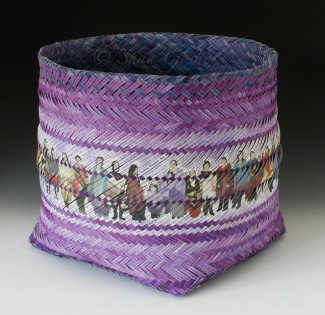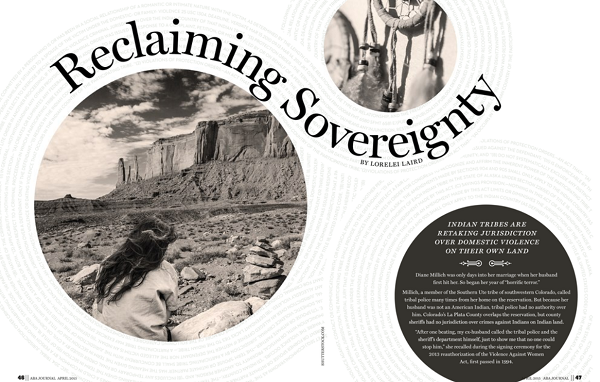Weaver inspires layout and art for domestic violence feature

“Reclaiming our Power” basket by Shan Goshorn
When we began thinking about how to present the story of a pilot project in which Indian tribes are finally able to prosecute non-Native perpetrators of domestic violence, we first looked for images depicting abuse and the solitary landscapes common to many tribal regions.
Then something unique caught our eye; a basket weaving by Eastern Band Cherokee multimedia artist Shan Goshorn, who is based in Tulsa, Oklahoma.
The basket is a masterful work, double woven using the text of the Violence Against Women Act. Specifically, she used the words from the sections of the act directly related to sovereignty and prosecuting abusers, who until the most recent 2013 reauthorization, could abuse on Indian land with impunity.
In the Journal’s feature, “Reclaiming Sovereignty: Indian tribes are retaking jurisdiction over domestic violence on their own land,” ABA Journal writer Lorelei Laird recounted the story of Diane Millich. Even though Millich called police many times to report her abusive husband, tribal police had no authority over her husband because he wasn’t an American Indian. And county authorities nearby similarly had no jurisdiction on tribal land.
“After one beating, my ex-husband called the tribal police and the sheriff’s department himself, just to show me that no one could stop him,” Millich is quoted saying.
Goshorn’s basket, titled “Reclaiming Our Power,” features actual photos of women from various tribal communities. They wear street clothes to signify that violence is ubiquitous. And while their shawls would identify them to anyone who regularly goes to powwows, Goshorn says their faces are obscured so they are essentially otherwise anonymous, representing every woman.
The inside of the basket features striking statistics about victims of violence on tribal lands:
• 3 out of 4 Native women will be physically assaulted in their lifetime.
• Native women are 10 times more likely to be murdered than any other group of women.
• 1 in 3 Native women will be raped in their lifetime.
• 88% of crimes against Indian women are by non-Natives.
In addition to the photos, the exterior features Sections 904, 905, and 910 of the reauthorization of the Violence Against Women Act, especially provisions recognizing the right of tribes to protect Indian women victimized by non-native perpetrators. These words are used in the ABA Journal’s layout design, woven through the narrative in the eight-page layout designed by Holly Tempka.

In the baskets, purple, black and blue colors represent the bruising associated with beatings and violence. Our layout images were more muted and somber.
Goshorn, who is federally licensed to work with injured and orphaned migratory songbirds, says the basket took her more than a year and a half to complete, and she disassembled it a dozen times in the process to get it just right.
Inspiration for the basket came after she’d been to a reading of “Sliver of a Full Moon,” a VAWA play written by lawyer and playwright Mary Kathryn Nagle, a citizen of the Cherokee Nation of Oklahoma.
This isn’t the first piece to make a strong statement. Goshorn, who describes herself as a political artist, has crafted about 200 baskets since she began weaving in 2008. While striking at a glance, the admirers are urged to take a closer look to absorb the full impact of each piece. Some messages and themes relate to her tribe in her home in Cherokee, North Carolina, but more feature statements from her intertribal observations.
Her first basket, “Pieced Treaties; Spider’s Web Treaty Basket,” featured sovereignty as it related to the tobacco compact between the Cherokee Nation and the state of Oklahoma. And another took on the horrors of the bloody lyrics from the song “Ten Little Indians” interwoven with an image of boys upon arrival at a boarding school, then later when they’d been “civilized.”
Shan Goshorn’s work can be seen on her site and in person May 1 through June 5 during an exhibit called “INTERTWINED: Stories of Splintered Pasts” at the Arts and Humanities Council of Tulsa Hardesty Arts Center.
Last updated April 23.



